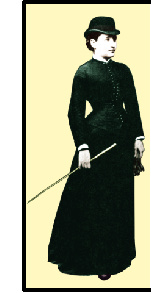|
|

|

|

|
|
|
| |
|
|
|
The doctor is called. It is fall of 1880 and the father is dying of tuberculosis in the family's big apartment in Vienna. The 21-year-old daughter has been nursing him at night. Her sleeping schedule is awry--she has nodded off when sitting at his bedside, and once in the summer country house she thought she saw snakes crawling from the walls, out to get him. Terrified, she tried to push one away and found that her fingers had turned into little snakes themselves. The next day, outside playing a ring toss game, she happened upon a stick--and that turned into a snake too. Now she has "absences" where she drops out of consciousness--drops out of time--and then suddenly rejoins the conversation or activity at hand. She's also bored, so bored that she makes up stories in her head, her own "private theater," while her body stays put. But that's not why the doctor has been called. She has a cough that won't go away, and her mother is worried. The family doctor listens and finds a "typical nervous cough"; Europe and America are full of hysterical women whose wombs have wandered to other parts of their bodies, causing symptoms ranging from fainting to choking to paralysis. When she recovers intermittently, she helps the poor and sick, which gives her satisfaction. As fall turns to winter, she develops more symptoms. She takes to her bed. She squints, hallucinates, complains of facial pains, paralyzed limbs, all worsening after her father's death. Her doctor prescribes morphine for pain and chloral hydrate to help her sleep. She
He massages her, hypnotizes her, visits once or twice a day. During hypnosis she tells him original fairy tales, after which she appears comforted. The doctor discovers that if he gets her to remember certain key events, her symptoms disappear. She has stopped drinking fluids, for example, getting her liquids from fruit instead. Under hypnosis he draws her back to a memory of seeing a dog drinking out of a glass. She was disgusted but too polite to say anything. Once she articulates this, she is able to drink a glass of water. Eureka! A clean incision--he can reach in to remove the offending pathogen. As satisfying as extracting a thorn embedded in a lion's paw. If this sounds familiar, it's because this is the story of the birth of psychoanalysis. The woman, referred to as "Miss Anna O." in a case study, called the method "chimney sweeping" and "the talking cure." In 1909 Sigmund Freud credited Anna O., and her doctor, colleague Josef Breuer, with the discovery that recalling incidents could relieve neurotic symptoms. (Five years later, Freud took all the credit himself.) In their 1895 Studies on Hysteria, Freud and Breuer write that Anna O. recovered and went about the rest of her life in "perfect health." Ernest Jones, who worshiped Freud and wrote the first biography of him, formally blew Anna O.'s cover in 1953 (but her identity was probably an open secret in Vienna, especially in Freud's circle). She was Bertha Pappenheim (1859-1936), a distinguished social worker, writer and feminist. She headed a Frankfurt orphanage, founded a home for unwed mothers and illegitimate children, co-founded and headed the first Jewish feminist organization in Germany, and traveled the world to fight the "white slave trade"--forced prostitution. Melinda Given Guttmann's highly readable book, The Enigma of Anna O., is the first full-length biography of Pappenheim. The book is valuable for its translations of some of Pappenheim's short stories and letters to religious philosopher Martin Buber, as well as its argument that Pappenheim helped with her own cure by telling and writing down stories. The biography also puts to rest the claims of Freud basher Mikkel Borch-Jacobsen that Anna O. was faking it. Guttmann brings together the two strands of Pappenheim's life: "The two major responses to the misogyny and patriarchy of her times were the flight into hysteria or the fight for feminist rights. Bertha is unique, for she embodies both responses." A famous legend, perpetuated by Freud and Jones, is that Breuer had decided to discontinue Bertha's treatment because it troubled his wife, who was growing bored and jealous at hearing her husband talk about this troubled young woman. On the day in 1882 that he ended her treatment, Breuer supposedly arrived home but was soon summoned back to his patient's apartment. He found her writhing in false childbirth. According to a letter Freud wrote in 1923, she said, "I'm having Dr. B.'s child." According to Jones, Breuer ran out the door, and was soon off on a second honeymoon with his wife in Venice. Freud wrote later that Anna had developed "transference love," and that Breuer did not understand. Breuer, in turn, noted that in Anna O., "the sexual component was astonishingly undeveloped." Scholars tend to agree that the two were emotionally intimate; Guttmann, following Plato, calls it metaphysical "soul-love." At any rate, after her treatment Pappenheim experienced far from "perfect health." She was in and out of sanitoria from 1881 to 1887, for symptoms that ranged from loss of language to severe jaw pain, as well as addiction to morphine and chloral hydrate. In between stays, she wrote and published stories anonymously, and in 1888 moved with her mother to Frankfurt, where she began volunteering to help the waves of Eastern European Jewish refugees fleeing pogroms and poverty. In some ways Pappenheim was progressive; she translated Mary Wollstonecraft and founded a home for wayward Jewish girls, with no uniforms or corporal punishment. She deplored the "useless" things that girls typically learned in school, as she had: In a time when women could not enter Austrian universities, her education had ended at 16. She criticized rabbis who considered women to be inferior to men. On fact-finding visits to brothels throughout Eastern Europe, Russia and the Middle East, she showed compassion for prostitutes. But Pappenheim was also a woman of her time; she dressed and thought like a Victorian, wearing long, dark dresses. She did not believe in women's suffrage or paid social work. She sought to help Eastern European Jews discard their "inferior" culture. She even denied the Nazi threat until it was unmistakable. By the time Pappenheim died of cancer in 1936, some 1,500 youths had passed through her institution in Neu Isenburg near Frankfurt. The home's main building was burned down during Kristallnacht in November 1938, and in 1942 adult workers and children were deported to ghettos and death camps. It's doubtful that any survived. In 1954, Pappenheim's profile graced a postage stamp in West Germany, part of a series titled "Helpers of Humanity," a convenient way for the new Germany to trumpet itself less than a decade after war's end. (What could be better: A Jewish woman, who died of cancer at home, buried in a visitable grave.) In The Enigma of Anna O., she emerges as lonely and strict,
dedicated but short-sighted, self-sacrificing and utterly bourgeois.
Not much of Guttmann's material will be new to scholars of psychoanalysis
or German Jewish feminist history, but the biography provides an
illuminating look at a feminist who is little known in the United
States. As Freud is continually defrocked and defended, it's important
to have such retellings as this, of the messy and real lives that
he imposed into neat case histories. S.L. Wisenberg is the author of The Sweetheart Is In, a short story collection. Her Web site is www.slwisenberg.com.
|






